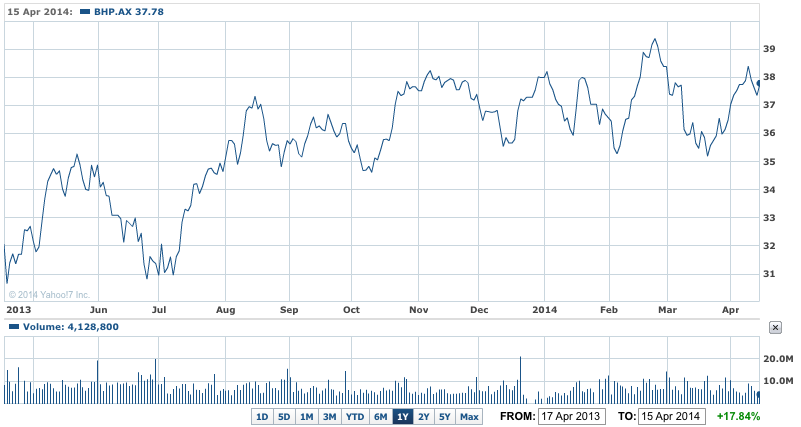Once again media and some investment analysts got the results of leading iron ore groups wrong because their estimates were too optimistic, or they have forgotten the way to compare quarterly results.
Specifically the analysts and media writers failed to consider, or didn’t give enough weight to the impact that the seasonal cyclonic weather and heavy rain can have on operations in the Pilbara iron ore province of Western Australia.
There have been several years of notable disruptions to production and sales (exports from Port Headland and or Dampier) in the last few years – the best known was at the start of 2011 (which saw heavy and sustained rain damage the Queensland coal industry for the best part of a year).
Those weather events (along with bad weather in Brazil) boosted global iron ore prices to record levels, and did the same for coal, especially coking coal.
That impact was evident at the start of 2013 and prices for iron ore rose notably. This year the impact was less noticeable, but still affected production and exports at Rio Tinto and Fortescue (FMG), and to a lesser extent BHP Billiton (BHP) for three to five days at most in January – February.
The common refrain heard on Tuesday and yesterday about Rio’s first quarter report was that it was ‘disappointing’ because production and sales were under the figures of the December quarter – but they were above those for first quarter of 2013.
And production figures and exports for BHP and Fortescue were also higher than a year ago – but Fortescue was more impacted by the wet weather than BHP.
But all three miners had record quarters (third quarters in the case of Fortescue and BHP, first quarter for Rio Tinto) – a point many analysts and investors forgot.
And in case you missed it, Chinese iron ore imports rebounded in the month of March and the quarter.
As we pointed out on Monday, Chinese customs data revealed that iron ore imports jumped 21% to 73.96 million tonnes last month, from 61.24 million tonnes in February. Imports were almost 15% above the level for March 2013.
First-quarter imports surged 19.4% to 222 million tonnes from the same period of last year. Shipments hit a record high of 86.82 million tonnes in January, as steelmakers built stocks ahead of the Lunar New Year shutdown.
Those figures go some way to explaining the quarterly performance of the iron ore operations of BHP, Rio and Fortescue.
In fact BHP did so well that it raised its production guidance for the year to June by five million tonnes (worth more than $US500 million at current prices), and also lifted its forecast for coking coal (metallurgical) production by 2.5 million tonnes (worth more than $US350 million).
BHP now reckons it will produce 217 million tonnes in the year to June from its Australian mines.
Rio reckons it will boost production in calendar 2014 to 295 million tonnes. Fortescue says its mine expansion to 155 million tonnes of annual production has finished and output will hit that level this year.
BHP increased iron ore exports for the March quarter by 23% to 57.6 million tonnes, with its equity share 49.6 million tonnes.
When BHP’s smaller Brazilian iron ore operations are added, that will total more than 227 million tonnes for the year, having produced 171 million tonnes for the year to date.
BHP 1Y – BHP Billiton joins Rio Tinto in strong Q1 iron ore performance

Production of coking coal – used in steelmaking – jumped 28% in the quarter to 11.5 million tonnes and is at a record 33 million tonnes for the nine months to date.
BHP cut its production guidance for its second biggest earner, petroleum, to 245 million barrels of oil equivalent (mmboe) from 250 million.
That’s because of the sale of its UK Liverpool Bay project in the UK and repairs activities to a major shale oil and gas producing asset in the US.
But petroleum production rose 10% in the quarter, from a year ago, to 61 mmboe.
Copper production for the quarter fell 5% to 414,000 tonnes but was up 2% for the nine months to March to 1.3 million tonnes. BHP is looking to expand copper production in the current quarter. Earnings though will be depressed by the 10% fall in world prices so far this year.
BHP also slipped out a 28% boost to the size of the copper reserves at its huge Escondida mine in Chile (Rio owns a share in this mine and didn’t mention this expansion on Tuesday).
BHP’s chief executive Andrew Mackenzie said in yesterday’s statement that the company’s productivity agenda was delivering outstanding results, underpinning a 10% increase in production so far this year. "We continue to expect cumulative production growth of 16 per cent over the two years to the end of the 2015 financial year," he said.
He said total capital exploration expenditure would fall 25% in the year to June and decline again in 2014-15. There was no mention in yesterday’s statement of the recent reports the company is looking to spin off of weakly performing aluminium, alumina, bauxite, and silver/lead production.
BHP shares edged 16c higher to end at $37.67.













